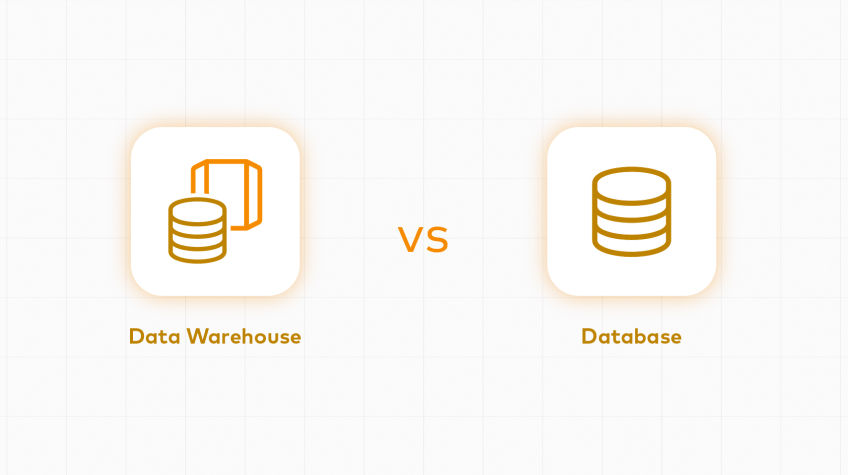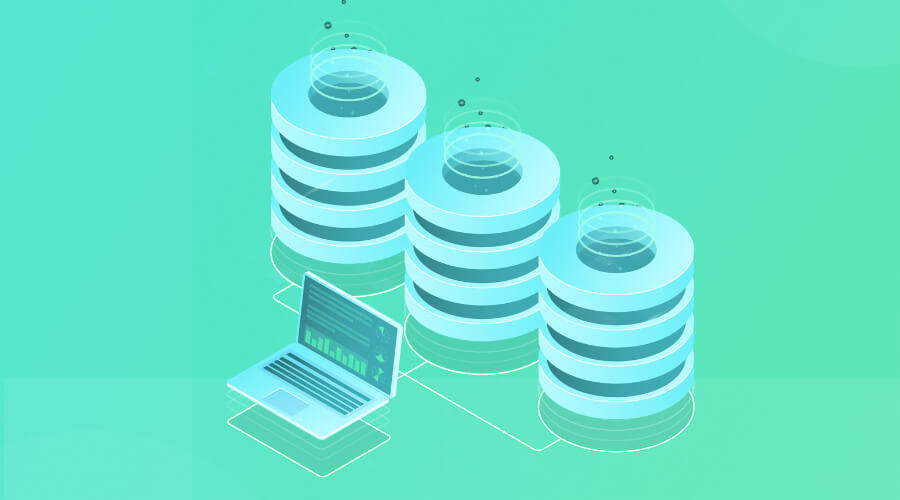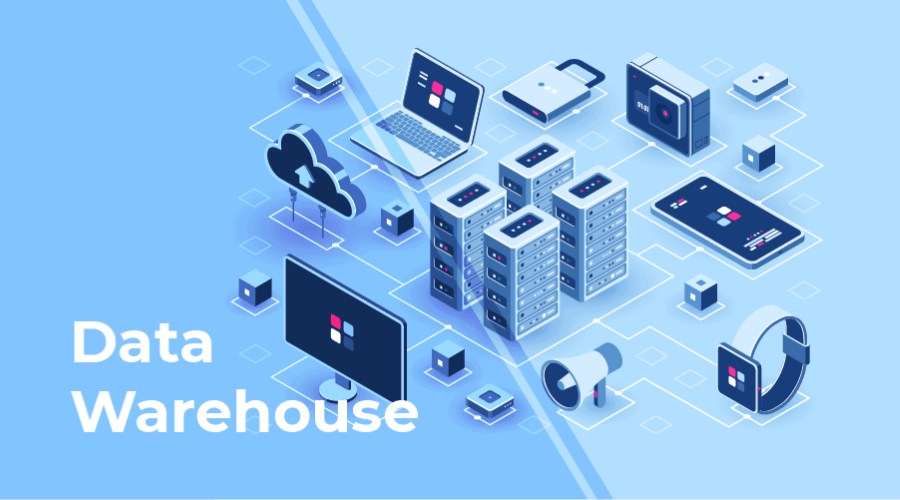
In today’s world of data-driven decision-making, organizations need to manage and analyze vast amounts of data effectively. Two essential concepts in this context are databases and data warehouses. Database and Data warehouse is used to store and manage data, they differ in purpose, design, and functionality.
A database is a cluster of data systematized and designed to facilitate efficient data repository, retrieval, and modification. It is designed to support transaction processing, which involves storing and updating data in real time. Databases are used for operational systems that handle day-to-day transactions, such as recording customer orders or processing financial transactions.
On the other hand, a data warehouse is an extensive, centralized data storage mainly developed to help business intellect and decision-making. It is optimized for storing and analyzing historical data from diverse origins, such as transactional systems, external data indexes, and flat files. Data warehouses are used to consolidate and transform data into a form that is appropriate for reporting, research, and data mining.
Understanding the differences between database and data warehouse is crucial for organizations to make informed decisions about storing and managing their data. By selecting the right technology for their needs, organizations can ensure that their data is efficiently collected, secure, and accessible for analysis and decision-making purposes.
What is a database?
A database is a cluster of data collected and structured to facilitate efficient data storage, retrieval, and modification. It is an essential element of most modern information systems. It stores and manages data for various applications and industries, including finance, healthcare, e-commerce, and government.
At its core, a database includes one or additional graphs, which are utilized to hold and organize data logically and systematically. Each table contains a set of columns, which define the different types of data that can be stored, and a set of rows, which represent individual records or instances of data. For example, a table for a customer database might have columns for name, address, email, and phone number, and each row would represent a single customer.

Databases also include a set of rules, or a schema, that define the relationships between different tables and the data types that can be stored in each. These rules ensure the data is stored consistently and standardized, making it easier to access, modify, and analyze.
One of the critical benefits of databases is their capability to handle considerable quantities of data proficiently and reliably. They can store millions of records and are designed to handle concurrent access by multiple users or applications, ensuring that data is always available when needed.
Databases also support advanced features such as indexing, which allows for fast searching and retrieval of data, and transactions, which ensure that changes to the data are atomic and consistent.
Databases are a crucial component of modern information systems and play a vital role in storing, managing and retrieving data for various applications and industries. Their ability to handle large amounts of data efficiently and reliably makes them an essential tool for associations looking to make data-driven findings and achieve perception from their data.
What is a data warehouse?
An ample, centralized data warehouse storage designed to help company intelligence and decision-making activities. It is optimized for storing and analyzing historical data from different origins, like transactional systems, external data indexes, and flat files.
Unlike operational databases for real-time transaction processing, data warehouses are optimized for querying and analysis.
They are typically organized around a dimensional model, a schema that structures the data in a way optimized for reporting and analysis. This involves managing the data into fact tables and dimension tables, which represent the different types of data and the relationships between them.

Credit: LinkedIn
Data warehouses also include tools and technologies supporting advanced reporting and analysis, such as online analytical processing (OLAP) and data mining. OLAP allows users to interactively analyze the data from different angles and perspectives, using features such as pivot tables and charts. Data mining, on the other hand, involves using statistical and machine learning algorithms to identify patterns and trends in the data.
One of the key benefits of data warehouses is their ability to consolidate data from multiple sources into a single, integrated view. This allows organizations to gain insights from their data that would only be possible if scattered across different systems and databases. Data warehouses also support data cleansing and transformation, which involves cleaning and standardizing the data to ensure that it is accurate and consistent.
Data warehouses are a powerful tool for organizations looking to gain insights from their data and make informed business decisions. By consolidating and organizing data from multiple sources into a single, integrated view, data warehouses provide a comprehensive and reliable source of information for reporting and analysis.
What is the use of a database
Here are some of the main benefits of databases:
- Data storage: Databases are primarily used for accumulating and handling immense quantities of data. They provide a centralized repository for data that can be easily accessed, modified, and searched by multiple users or applications.
- Transaction processing: Many databases are designed to support real-time transaction processing, such as recording customer orders, updating inventory, or processing financial transactions. They are enhanced for quick read and note functions and ensure that data remains consistent and accurate.
- Data analysis: Databases can store data for analysis and reporting purposes. They can extract, transform, and load data from multiple sources into a single data warehouse or analytical database, which can be queried and analyzed using tools such as SQL and BI dashboards.
- Record keeping: Databases are commonly used for record-keeping, such as tracking employee records, customer information, or medical records. They provide a secure and reliable way to store and manage sensitive data while ensuring authorized users can easily access and update it.
- E-commerce: Many e-commerce websites use databases to store and manage product information, customer profiles, and transactional data. Databases can help ensure that inventory levels are accurate, orders are processed correctly, and customer data is protected and secure.
- Content management: Databases are often used in content management systems (CMS) to store and manage digital content such as text, images, and videos. This enables easy retrieval and management of content and ensures the right content is delivered to the right audience.
- Research: Databases are widely used in academic and scientific research to store and manage large datasets. They provide a reliable and scalable way to store and analyze data, enabling researchers to make discoveries and insights.
What are the usages of a data warehouse
Here are a few of the uses of data warehouses:
- Data analysis: Data warehouses are primarily used for storing and analyzing enormous quantities of chronological data from numerous origins. They provide a consolidated and integrated view of data that can be easily queried and analyzed using SQL and BI dashboards.
- Business intelligence: Data warehouses are used for business intelligence and decision-making activities. They provide insights into trends and patterns in data, allowing institutions to make data-driven judgments and develop effective strategies.
- Reporting: Data warehouses provide a centralized and reliable data source for reporting purposes. They enable users to create reports and visualizations that summarize and present data meaningfully.
- Data mining: Data warehouses can be used for data mining, which involves using statistics and artificial intelligence algorithms to recognize habits and directions in data. This can help organizations to make predictions and gain insights that would not be possible through traditional reporting and analysis.
- Planning and forecasting: Data warehouses can be used for planning and forecasting activities, such as budgeting and resource allocation. Associations can precisely judge prospective buys and resource allocation by analyzing historical data.
- Customer analytics: Data warehouses can store and analyze buyer data, like buy records, demography, and choices. This enables organizations to develop targeted marketing campaigns and improve customer engagement.
- Supply chain management: Data warehouses can be used for supply chain management, such as following inventory levels and observing a supplier’s execution. This can help organizations to improve their supply network and enhance their effectiveness.
Data warehouses are primarily used for storing and analyzing historical data for business intelligence and decision-making activities. They provide a reliable and consolidated view of data from multiple sources, enabling organizations to gain insights and make informed decisions.
Characteristics of database
Here are some of the main characteristics of databases:
- Data organization: Databases are designed to organize data in a rational and structured form. This involves defining tables, fields, and relationships that promote effective data depository and recovery.
- Data integrity: Databases ensure the accuracy and consistency of data by enforcing rules and constraints on the data. For example, a database may require that specific fields are always populated or that values in one area depending on values in another.
- Data security: Databases provide a secure way to store and manage sensitive data. This involves implementing authentication and authorization controls to ensure only official users can use the data.
- Scalability: Databases can handle large amounts of data and can be scaled to meet the needs of growing organizations. They can support multiple users and applications simultaneously without compromising performance.
- Accessibility: Databases can be accessed by multiple users or applications from different locations. This enables collaboration and sharing of data across an organization.
- Data recovery: Databases are designed to ensure that data can be recovered in case of a system failure or data loss. This involves executing backup and retrieval procedures to confirm data is preserved.
- Querying and reporting: Databases provide tools and features for querying and reporting on data. This includes using SQL (Structured Query Language) to extract data and means for generating reports and visualizations.
- Transaction processing: Some databases are designed for real-time transaction processing, such as recording customer orders or processing financial transactions. These databases are optimized for fast read and write operations and ensure that data remains consistent and accurate.
Databases provide a logical and structured way to organize, manage, and secure data. They are scalable, accessible, and designed to ensure the accuracy and integrity of data while providing tools for querying and reporting on data.
Characteristics of data warehouse
Here are some of the main characteristics of data warehouses:
- Data integration: Data warehouses are designed to integrate data from numerous origins, such as transferable databases, flat files, and exterior sources. This involves transforming and consolidating data to create a unified and consistent view.
- Historical data: Data warehouses store large amounts of historical data, typically spanning several years. This enables organizations to analyze tendencies and routines in data over time and make accurate conclusions established on historical performance.
- Subject-oriented: Data warehouses are organized around business subjects, such as sales, marketing, or finance. This enables users to analyze data from a business perspective rather than a technical or operational perspective.
- Non-volatile: Data warehouses are non-volatile, meaning data is not updated or deleted once loaded into the warehouse. This ensures that historical data remains intact and can be utilized for research and reporting.
- Optimized for querying and analysis: Data warehouses are designed to support complex queries and research of large amounts of data. This involves optimizing data structures, indexing, and query performance to ensure that questions run efficiently.
- Aggregated data: Data warehouses often contain aggregated data, such as summaries and totals, and detailed transactional data. This enables users to quickly analyze and report on high-level trends and patterns in data.
- Business intelligence and analytics: Data warehouses are primarily used for business intelligence and analytics activities. They provide a consolidated and integrated view of data that can be easily analyzed and reported on using tools such as SQL and BI dashboards.
- Separation from operational systems: Data warehouses are typically separate from operating systems, such as transactional databases. This ensures that reporting and analysis activities do not impact the performance or integrity of operational procedures.
Data warehouses are designed to integrate and consolidate extensive recorded data from numerous authorities and provide a subject-oriented and optimized environment for the authentication and analyzing data. They are primarily used for business intelligence and analytics activities and are separate from operational systems to ensure that performance is not impacted.
Difference between Database and Data Warehouse
| Category | Database | Data warehouse |
| Purpose | Used to store and manage operational data | Used for analyzing and reporting on large volumes of historical data |
| Type of data | Transactional data for day-to-day operations | Historical data for analysis and decision-making |
| Data structure | Normalized to minimize redundancy and maintain consistency | Denormalized to optimize query performance |
| Schema design | Designed for specific application requirements | Designed for optimized querying and reporting |
| Data integration | Supports real-time data integration and updates | Supports batch data integration from multiple sources |
| Querying | Supports ad hoc querying and transactional processing | supports complex queries and analytics |
| Performance | Optimized for transactional processing and concurrent access | Optimized for reporting and analysis |
| Data volume | Handles smaller volumes of data | Handles larger volumes of data |
| Users | Used by application developers, administrators, and end-users | Used by business analysts, data scientists, and executives |
Applications of database
Here are some typical applications of databases:
- E-commerce websites use databases to store and manage product information, customer data, and transactions.
- Healthcare organizations use databases to manage patient records, track medical history, and maintain an inventory of medical supplies.
- Financial institutions use databases to manage customer accounts, transactions, and financial data.
- Educational institutions use databases to manage student records, course information, and academic data.
- Manufacturing companies use databases to manage inventory, track orders and monitor supply chain operations.
- Social media platforms use databases to store and manage user data, posts, and interactions.
- Customer relationship management (CRM) systems use databases to collect buyer data, sales leads, and communication history.
- Human resources departments use databases to manage staff records, salary details, and perks data.
- Transportation companies use databases to manage schedules, track shipments, and monitor vehicle performance.
- Government agencies use databases to manage citizen records, tax information, and public safety data.
These are just a few examples of the wide range of database applications. Databases are used in nearly every industry and sector and are essential for managing and organizing large volumes of data efficiently and effectively.
Applications of data warehouse
Here are some common applications of data warehouses:
- Business intellect and analytics applications use data warehouses to hold and diagnose enormous volumes of historical data to gain insights into business trends, patterns, and opportunities.
- Marketing departments use data warehouses to track customer behavior, preferences, and purchase history to understand their target audience better and tailor marketing campaigns.
- Financial institutions use data warehouses to track transactions, monitor risk, and identify fraudulent activity.
- Healthcare organizations use data warehouses to analyze patient data to improve patient outcomes, reduce costs, and identify potential health risks.
- Retailers use data warehouses to track sales data, inventory levels, and customer behavior to optimize their supply chain and improve their bottom line.
- Government agencies use data warehouses to analyze demographic data, track public safety trends, and monitor public health.
- Educational institutions use data warehouses to analyze student data, monitor academic performance, and identify opportunities for improvement.
- Transportation companies use data warehouses to track vehicle performance, optimize routing, and improve customer service.
- Energy companies use data warehouses to analyze energy consumption, monitor power grids and identify potential efficiency improvements.
These are some illustrations of the wide range of applications for data warehouses. Data warehouses are essential for organizations that must store, manage, and analyze large volumes of historical data to gain insights and make data-driven decisions.
Disadvantages of database
Here are some common disadvantages of databases:
- Complexity: Databases can be complicated to design, execute, and sustain, needing technical proficiency and mastery.
- Cost: Executing and holding a database can be costly, including hardware, software, licensing fees, and personnel costs.
- Security: Databases can be vulnerable to security breaches, resulting in the loss or theft of sensitive data.
- Data consistency: Ensuring data consistency across a database can be challenging, especially when dealing with multiple users and concurrent updates.
- Scalability: Scaling a database to handle increasing volumes of data or users can be challenging and require significant investment.
- Data redundancy: Databases can be prone to data redundancy, where the same data is stored in multiple locations, resulting in data inconsistencies and wasted storage space.
- Backup and recovery: Backing up and recovering a database can be time-consuming and complex, requiring specialized knowledge and tools.
- Performance: Poorly designed or implemented databases can suffer from performance issues, impacting application performance and user experience.
- Vendor lock-in: Choosing a specific database vendor can lead to vendor lock-in, where switching to a different database solution becomes difficult or expensive.
These are some of the illustrations of the potential disadvantages of databases. While databases are essential for managing and organizing large volumes of data, they come with challenges and considerations.
Disadvantages of data warehouse
Here are some common disadvantages of data warehouses:
- Cost: Implementing and maintaining a data warehouse can be expensive, including hardware, software, licensing fees, and personnel costs.
- Complexity: Data warehouses can be complicated to develop, execute, and sustain, demanding technical proficiency and expertise.
- Data integration: Integrating data from multiple sources into a data warehouse can be challenging and require significant effort to ensure data quality and consistency.
- Data cleansing: Data in a data warehouse must be cleansed and transformed to ensure consistency and accuracy, which can be time-consuming and complex.
- Data latency: Data in a data warehouse is typically not real-time, which can limit its usefulness for specific applications and use cases.
- Performance: Queries against a large data warehouse can be slow and resource-intensive, impacting application performance and user experience.
- Vendor lock-in: Choosing a specific data warehouse vendor can lead to vendor lock-in, where switching to a different solution becomes difficult or expensive.
- Data governance: Managing data governance and access controls in a data warehouse can be complex and challenging, especially in regulated industries.
- Data silos: Data warehouses can create data silos, where different teams or departments can access different data sets, limiting collaboration and hindering data-driven decision-making.
These are a few illustrations of the potential disadvantages of data warehouses. While data warehouses are essential for analyzing and reporting large volumes of historical data, they come with their challenges and considerations.
Which is the best?
A database, or a data warehouse, is not straightforward and depends on the organization’s or user’s specific needs and requirements.
A database is a software application used to accumulate, organize, and handle data in a structured way, typically in real time. Databases are designed to handle transactional workloads optimized for quick data retrieval and updates. Databases are usually used in online transaction processing (OLTP) systems, where data is frequently updated and accessed in real time.
Conversely, a data warehouse is an ample, centralized storage designed to help company intellect and analytics. Data warehouses are optimized for querying and analyzing large volumes of historical data and are typically used in online analytical processing (OLAP) systems. Data warehouses are designed to support complex queries and reporting and generally are used to gain insights into business trends, patterns, and opportunities.
In general, databases are better suited for real-time transactional workloads, while data warehouses are better suited for historical data analysis and reporting. However, this distinction is only sometimes clear-cut, and there can be overlapping among the two systems. Some organizations may use a database and a data warehouse depending on their specific needs and use cases.
Also Read: How to Choose the Right Database for IoT: A Comprehensive Guide
Eventually, deciding which system to utilize will depend on the association’s necessities, funding, and aids. It’s important to carefully evaluate the strengths and weaknesses of databases and data warehouses and consider factors such as scalability, data integration, data quality, performance, and security when deciding.
In conclusion, while databases and data warehouses store and manage data, they are optimized for different workloads and serve other purposes. Databases are designed to handle real-time transactional workloads. They are optimized for quick data retrieval and updates, while data warehouses are optimized for querying and analyzing large volumes of historical data.
While there can be overlap between the two systems, it’s essential to carefully evaluate your organization’s specific needs and use cases to determine which method is best suited for your needs. A database may be the better choice for organizations that require real-time transactional processing. In contrast, organizations that require historical data analysis and reporting may find a data warehouse more suitable.
Regardless of which system you choose, it’s essential to ensure that your data is appropriately managed, integrated, and secured and that your system is scalable and efficient enough to meet your organization’s needs now and in the future. By carefully evaluating your options and making a data-driven conclusion, you can confirm that you have the proper system to support your data management and analysis needs. We wish this blog on the difference between databases and data warehouse is useful to the readers.






